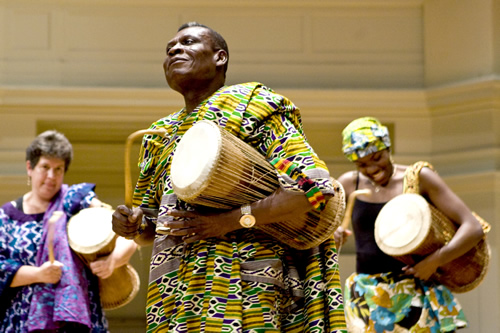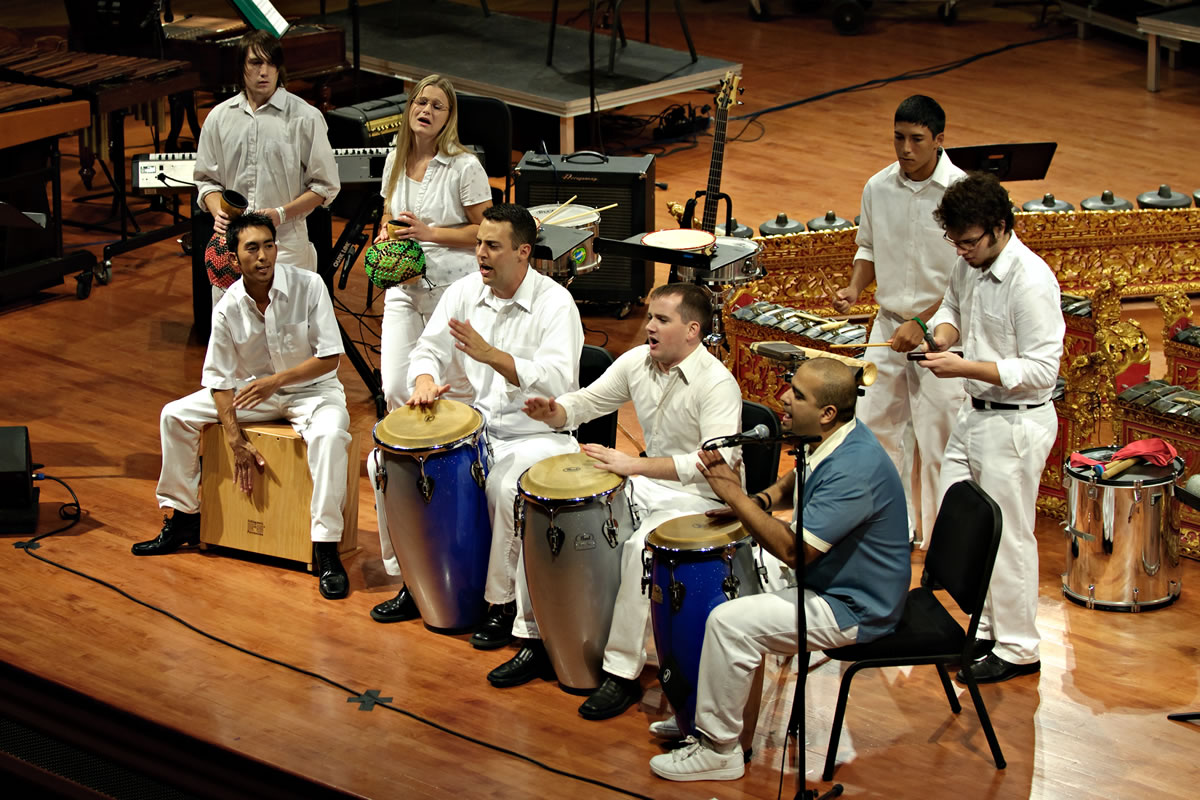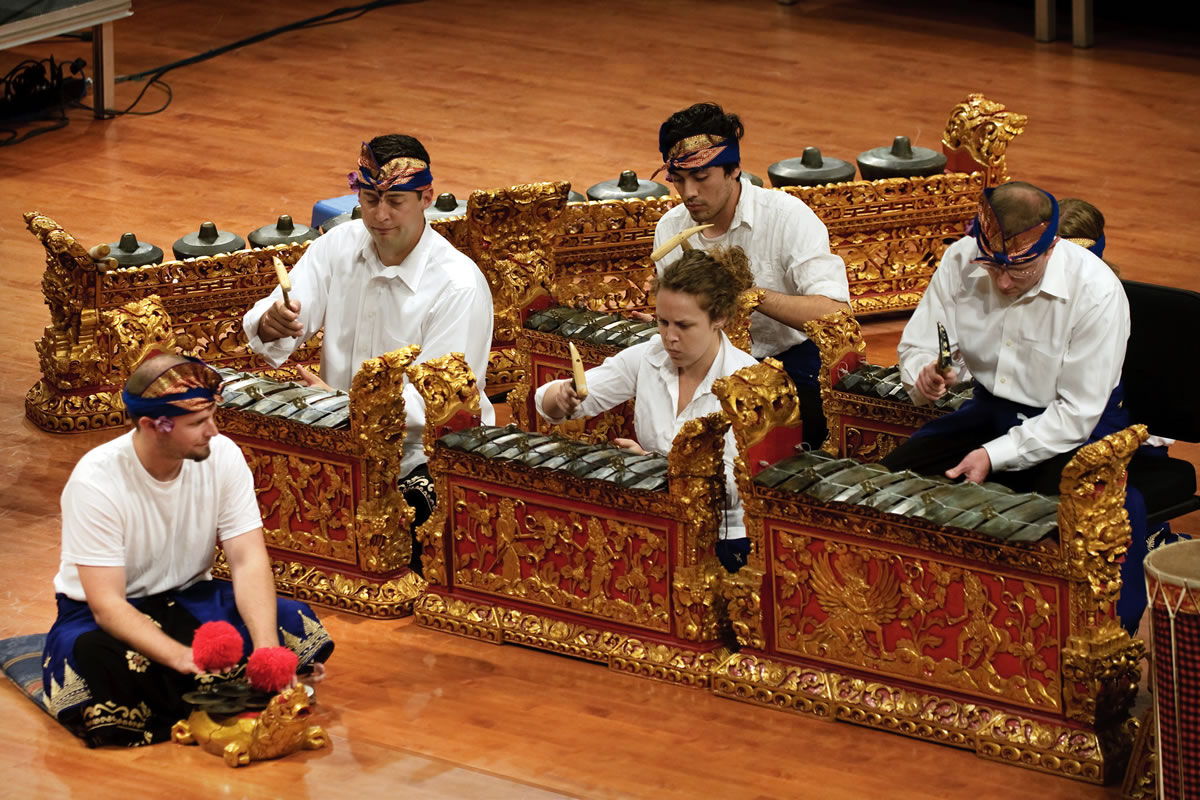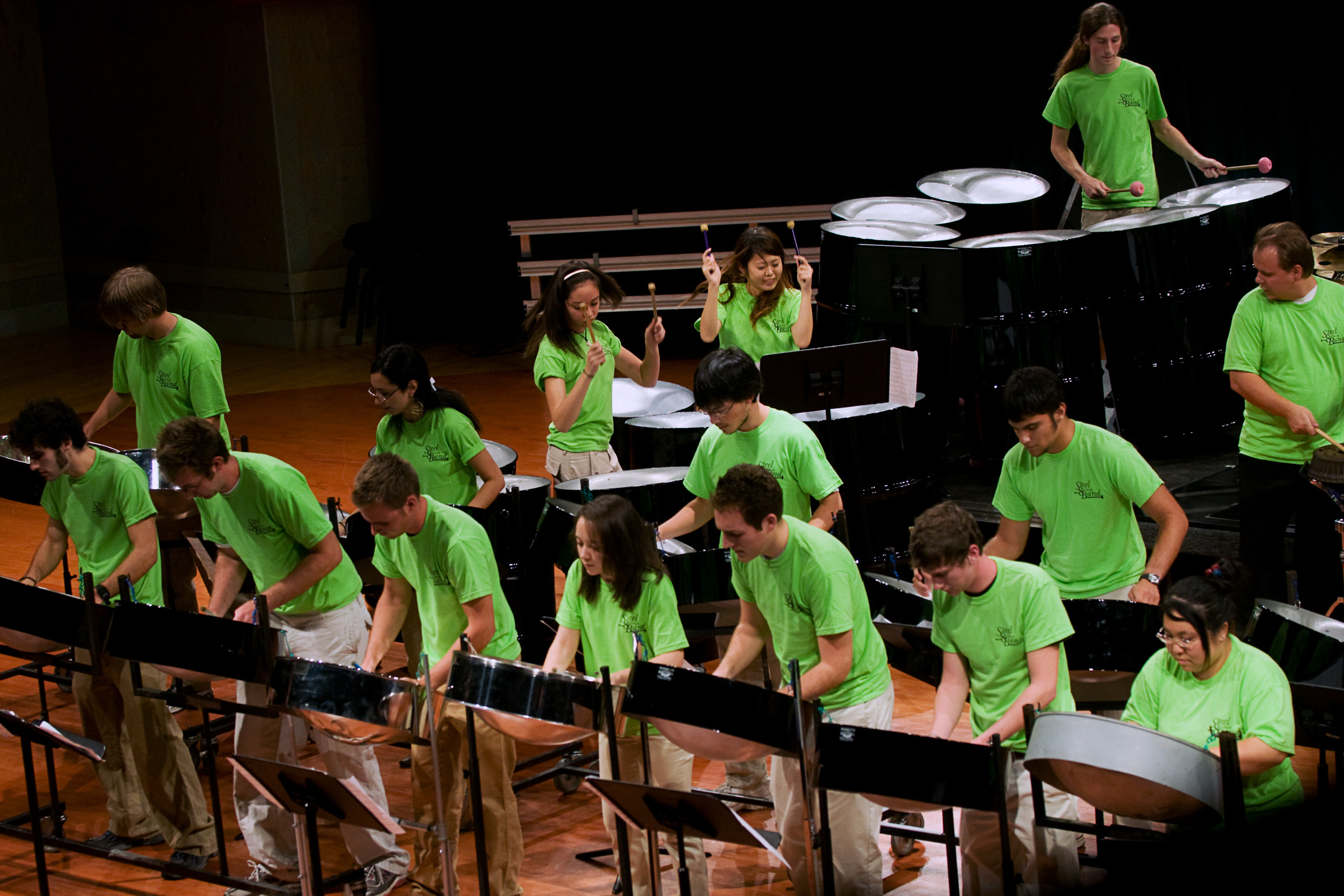 African ensemble:
African ensemble:
The music that the African Ensemble is performing is a small part of the diverse and rich musical heritage of Africa. The music is of the Ashanti people of the central region and the Ewe-speaking people from the coastal region of Ghana, West Africa and is characterized by its "hot" rhythmic content. The instruments contained in this ensemble are the Gankogui bells, Axaste, and many carved drums including the Kaganu, the Kidi, the Sogo, the Atsimevu, the Atumpan, and the Donno.
This preparatory ensemble offers its members the study of Afro Latin American rhythmic and stylistic fundamentals that mainly focus on Cuban and Brazilian traditions. The subjects covered involve the foundations of hand percussion techniques, Brazilian/Cuban rhythmic fundamentals, the Cuban percussion trio functionality, and a survey of Cuban/Brazilian musical styles. The participants have the opportunity to apply the concepts learned in their artistic disciplines their performance of the fall/spring semester concert.
 Afro-Cuban ensemble:
Afro-Cuban ensemble:
This ensemble studies and performs repertoire from the African diaspora in the Spanish Caribbean with a focus on Afro Cuban and Afro Puerto Rican traditions. The students will experience the performing of music from the Cuban Rumba complex (Yambú, Guaguancó, and Columbia), the Afro Cuban folkloric traditions (Bembé, Abakuá, and Conga de Comparsa among others), and the Afro Puerto Rican styles of Bomba and Plena. The ensemble members are encouraged to apply these languages in their own arrangements of the traditional Cuban repertoire, or in original Afro Cuban interpretations of contemporary popular songs or music. The participants have the opportunity to apply the concepts learned in their performance of the fall/spring semester concert and performances in other events.
 Brazilian ensemble:
Brazilian ensemble:
This ensemble offers its members the opportunity to study and perform both traditional and contemporary repertory from the diverse Brazilian musical tradition. The group is configurated in the long-established Samba School “Bateria” or “Bloco” format to perform all Samba styles, but will also adjust to accommodate the instrumentation required by other Brazilian traditions like Samba Reggae, Afoxé, Maracatú, and forró styles. The participants have the opportunity to apply the concepts learned in their performance of the fall/semester concert and performances in other events.
 Classical Percussion ensembles:
Classical Percussion ensembles:
There are three classical percussion ensembles at UNT, The Percussion Ensemble, The Percussion Players and The Percussion Group. These ensembles perform regularly and are devoted to contemporary and classical percussion ensemble literature. The Percussion Ensemble regularly premieres new works and has toured Belgium, France, Poland and Croatia. The Percussion Ensemble as well as The Percussion Players have performed at recent PASICs as well as at the Texas Music Educator's Conference. The Percussion Ensemble has recorded two albums, Vespertine Formations and Marimba Heritage, and often commissions new works by leading percussion composers.
 Drumlines:
Drumlines:
UNT has two drumlines, the indoor drumline and the UNT Green Brigade Marching Band drumline. The indoor drumline has won the PASIC College Marching Drumline Competition 21 times and has been recognized as a leader in indoor drumline performance. This unique ensemble combines the diverse styles of world percussion music with the traditions of the marching ensemble. From steel pan to Latin hand drums, look for a variety of sounds from this energetic ensemble. Their exciting presentations offer a wide variety of visual effects, drill and choreography.
 Gamelan:
Gamelan:
UNT's Balinese Gamelan Ensemble is named Bwana Kumala (Jewel of the World). Our Gamelan orchestra was purchased in Bali in 2004 and shipped to Texas. This style of gamelan, which consists of metallophones and gongs, has a unique tuning system where pairs of instruments are detuned from each other by 7 cycles to create a vibrato (called ombak) which adds a shimmer to the orchestra's sound. Students in the gamelan will learn traditional Balinese music consisting of interlocking parts called kotekan, along with modern compositions. The Gamelan performs at the UNT Global Rhythms concert at the end of each semester. Bwana Kumala performed at the 2009 PASIC as the first winner of the PAS World Music Ensemble Competition.
 South Indian Cross-Cultural ensemble:
South Indian Cross-Cultural ensemble:
The Indian percussion ensemble developed in South India due to the availability of
a wide variety of percussion instruments and used in temple rituals. These instruments
are different in every state. There are specific rhythms assigned to different rituals.
As the Karnatic (South Indian) music adapted a concert format during the early 20thcentury, instruments such as Mridangam (Two headed barrel drum), Kanjira (Frame drum),
Ghatam (Clay pot), Morsing (Jew's harp) and Konnakol (Vocal percussion) developed
into an ensemble, improvisatory in nature with a healthy spirit of competition among
the performers.. The ensemble performs compositions based on Karnatic music, a South
Indian microtonal, modal art form, built upon a highly developed theoretical foundation,
with melody and rhythm as its two vectors.
Instead of teaching students to play traditional instruments, Poovalur Sriji, a master
mridangam player, conceived and encourages ensemble members to make music with their
own instruments, therefore, some type of instrumental proficiency is required.
 Steel Bands:
Steel Bands:
Steel drum bands, a trademark of the Caribbean, are rapidly growing in popularity in the United States. These bands originated in Trinidad where groups participating in Carnival activities played on paint cans and oil barrels, which have tuned areas beaten into their surfaces. The various sets of drums, which are constructed by hand from 55-gallon oil drums, comprise a family of soprano, alto, tenor, and bass voices. Since their creation, steel drum construction has become a highly developed art form. Today, the "pan" is a legitimate, versatile instrument capable of expressing delicate passages in classical music as well as in traditional upbeat calypso marches and popular dance music. In 1982, UNT became one of the first universities to start a steel band program. UNT students currently have the opportunity to perform in two steel bands.